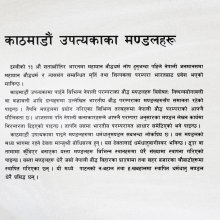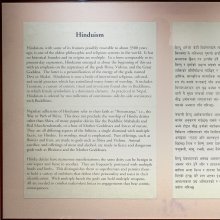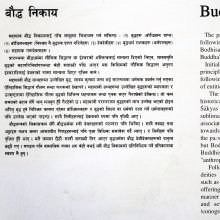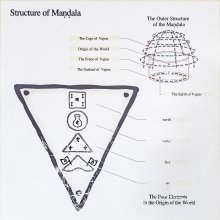Parampara, Paramparā, Paraṃpara, Pāraṃpara: 22 definitions
Introduction:
Parampara means something in Buddhism, Pali, Hinduism, Sanskrit, Jainism, Prakrit, the history of ancient India, Marathi, Hindi. If you want to know the exact meaning, history, etymology or English translation of this term then check out the descriptions on this page. Add your comment or reference to a book if you want to contribute to this summary article.
Images (photo gallery)
In Hinduism
Yoga (school of philosophy)
Source: ORA: Amanaska (king of all yogas): A Critical Edition and Annotated Translation by Jason Birch1) Paraṃpara (परंपर) refers to the “streams (of intentional thinking)”, according to the Amanaska Yoga treatise dealing with meditation, absorption, yogic powers and liberation.—Accordingly, as Īśvara says to Vāmadeva: “[...] [When the gaze] is focused constantly, [it results] in forcibly cutting off the streams of intentional thinking (saṅkalpa-paraṃpara). [Then,] because of the disappearance of its object [of focus], the gaze, while very gradually weakening, [finally] ceases. The more the mind becomes steady through the constant practice [of focusing the gaze], so does breath, speech, body and gaze. [...]”.
2) Paramparā (परम्परा) refers to the “successions (of cycles)” (in each cosmic period), according to the Mokṣopāya.—Accordingly: “[He is] known as Bhuśuṇḍa [because] his long life is known throughout the world. He is strong-minded because he has seen the coming and going of the Ages [of the world], and he is exhausted counting the successions of cycles (cakra-paramparā) in each cosmic period”.

Yoga is originally considered a branch of Hindu philosophy (astika), but both ancient and modern Yoga combine the physical, mental and spiritual. Yoga teaches various physical techniques also known as āsanas (postures), used for various purposes (eg., meditation, contemplation, relaxation).
Sports, Arts and Entertainment (wordly enjoyments)
Source: archive.org: Syainika Sastra of Rudradeva with English Translation (art)Paramparā (परम्परा) refers to a “series (of sins)”, according to the Śyainika-śāstra: a Sanskrit treatise dealing with the divisions and benefits of Hunting and Hawking, written by Rājā Rudradeva (or Candradeva) in possibly the 13th century.—Accordingly, “The killing of animals leads to a series of sins (doṣa-paramparā). Sacrificial animals are said to be fourteen in number. Some are domestic, others wild. The slaughter of these animals, if not sprinkled aver with water for sacrificial purposes, is a sin. [...]”.

This section covers the skills and profiencies of the Kalas (“performing arts”) and Shastras (“sciences”) involving ancient Indian traditions of sports, games, arts, entertainment, love-making and other means of wordly enjoyments. Traditionally these topics were dealt with in Sanskrit treatises explaing the philosophy and the justification of enjoying the pleasures of the senses.
In Buddhism
Mahayana (major branch of Buddhism)
Source: academia.edu: A Study and Translation of the GaganagañjaparipṛcchāParaṃparā (परंपरा) refers to “continuous succession (of thought)”, according to the Gaganagañjaparipṛcchā: the eighth chapter of the Mahāsaṃnipāta (a collection of Mahāyāna Buddhist Sūtras).—Accordingly, “Son of good family, these are eight pure vigours of bodhisatvas. What are the eight? To wit, (1) vigour to adorn his body but the body is not the objective support since it is distinguished as a reflection; (2) vigour to accomplish proper speech although the speech cannot be perceived since it is distinguished as voidness; (3) vigour to put the thought into the state of concentration although the thought is not the objective support since it is imagined by the true state of thought; (4) vigour to attain all aspects of perfection (pāramitā) although they cannot be perceived since they are imagined by the true nature of dharma (dharmatā) which is the extinction of the continuous succession of thought (citta-paraṃparā); [...]”.

Mahayana (महायान, mahāyāna) is a major branch of Buddhism focusing on the path of a Bodhisattva (spiritual aspirants/ enlightened beings). Extant literature is vast and primarely composed in the Sanskrit language. There are many sūtras of which some of the earliest are the various Prajñāpāramitā sūtras.
In Jainism
General definition (in Jainism)
Source: The University of Sydney: A study of the Twelve ReflectionsParamparā (परम्परा) refers to the “uninterrupted (series of births)”, according to the 11th century Jñānārṇava, a treatise on Jain Yoga in roughly 2200 Sanskrit verses composed by Śubhacandra.—Accordingly, “Astonishingly, external [and] internal asceticism is undergone by honourable mendicants who are wise [and] alarmed by the continuous series of births [com.—bhava-paramparā-śaṅkita—‘those who are alarmed by the uninterrupted series of births’] [in the cycle of rebirth]. In that regard, external asceticism is declared to be of six kinds beginning with fasting while internal [asceticism] is also of [six] kinds on account of the divisions beginning with atonement”.
Synonyms: Saṃtāna.
Source: SOAS Research Online: Prekṣā meditation: History and MethodsParaṃpara (परंपर) refers to “succession”; as opposed to Aparaṃpara—“succession-less” which refers to one of the 46 qualities of the soul to be meditated on in the “Practice of Meditation on Liberated Souls (Siddhas)”, according to Jain texts like Ācārāṅga (5.6.123-140), Ṣaṭkhaṇḍāgama (13.5.4.31) and Samayasāra (1.49).—The pure soul can be recognised by meditation on its true nature, represented by the liberated souls of the Siddhas. [...] The qualities of the soul to be meditated on as truly mine are: [e.g., My soul is succession-less (a-paraṃpara)] [...] The meditation on such extended fourty-five qualities of the pure soul presents the niśacaya-naya, which is aligned with Kundakunda’s approach.

Jainism is an Indian religion of Dharma whose doctrine revolves around harmlessness (ahimsa) towards every living being. The two major branches (Digambara and Svetambara) of Jainism stimulate self-control (or, shramana, ‘self-reliance’) and spiritual development through a path of peace for the soul to progess to the ultimate goal.
India history and geography
Source: Cologne Digital Sanskrit Dictionaries: Indian Epigraphical GlossaryPārampara.—(EI 15), same as paramparā-balīvarda-grahaṇa; refers to the obligation of the villagers to supply bullocks in suc- cession for the cart of a royal agent on tour in their villages. Note: pārampara is defined in the “Indian epigraphical glossary” as it can be found on ancient inscriptions commonly written in Sanskrit, Prakrit or Dravidian languages.
--- OR ---
Paramparā.—cf. a-paramparā-balīvarda (IE 8-5); ‘succession’; refers to the obligation of the villagers to supply bullocks for the cart of the touring officers visiting different villages in suc- cession. Note: paramparā is defined in the “Indian epigraphical glossary” as it can be found on ancient inscriptions commonly written in Sanskrit, Prakrit or Dravidian languages.

The history of India traces the identification of countries, villages, towns and other regions of India, as well as mythology, zoology, royal dynasties, rulers, tribes, local festivities and traditions and regional languages. Ancient India enjoyed religious freedom and encourages the path of Dharma, a concept common to Buddhism, Hinduism, and Jainism.
Languages of India and abroad
Pali-English dictionary
Source: BuddhaSasana: Concise Pali-English Dictionaryparamparā : (f.) lineage; succession; series.

Pali is the language of the Tipiṭaka, which is the sacred canon of Theravāda Buddhism and contains much of the Buddha’s speech. Closeley related to Sanskrit, both languages are used interchangeably between religions.
Marathi-English dictionary
Source: DDSA: The Molesworth Marathi and English Dictionaryparamparā (परंपरा).—f (S) Continuous arrangement or order; regular succession. Ex. of comp. dharmaparamparā, lōka- paramparā, uktiparamparā, rājaparamparā. 2 (Abridged from vaṃśaparamparā) Race or lineage.
Source: DDSA: The Aryabhusan school dictionary, Marathi-Englishparampara (परंपर) [or rāṃ, or रां].—ad Imit. of the sound of cloth splitting and tearing.
Marathi is an Indo-European language having over 70 million native speakers people in (predominantly) Maharashtra India. Marathi, like many other Indo-Aryan languages, evolved from early forms of Prakrit, which itself is a subset of Sanskrit, one of the most ancient languages of the world.
Sanskrit dictionary
Source: DDSA: The practical Sanskrit-English dictionaryParaṃpara (परंपर).—a. One following the other; परंपराणां भक्षिष्ये वानराणां मृतं मृतम् (paraṃparāṇāṃ bhakṣiṣye vānarāṇāṃ mṛtaṃ mṛtam) Rām.4.56.5.
2) Successive, repeated.
-raḥ 1 A great-grandson.
2) A kind of deer.
-rā 1 An uninterrupted series, regular series, succession; महतीयं खल्वनर्थपरंपरा (mahatīyaṃ khalvanarthaparaṃparā) K.13; कर्णपरंपरया (karṇaparaṃparayā) 'from ear to ear, by hear-say'; परंपरया आगम् (paraṃparayā āgam) 'to be handed down in regular succession'.
2) A row, line, collection, assemblage (of regular things); तोयान्तर्भास्करालीव रेजे मुनिपरंपरा (toyāntarbhāskarālīva reje muniparaṃparā) Kumārasambhava 6.49; R.6.5,35,4;12.1.
3) Method, order, due arrangement; एवं परंपराप्राप्तमिमं राजर्षयो विदुः (evaṃ paraṃparāprāptamimaṃ rājarṣayo viduḥ) Bhagavadgītā (Bombay) 1.2.
4) Race, family, lineage.
5) Injury, hurting, killing.
--- OR ---
Pāraṃpara (पारंपर).—a. Further, future.
-rī Regular succession, order.
Source: Cologne Digital Sanskrit Dictionaries: Shabda-Sagara Sanskrit-English DictionaryParampara (परम्पर).—mfn.
(-raḥ-rā-raṃ) Successive, proceeding from one to another, from father to son, &c. m.
(-raḥ) 1. A sort of deer. 2. A great-great-grandson. f.
(-rā) 1. Race, progeny, lineage. 2. Order, method, continuous arrangement, regular series or succession. 2. Hurting, killing, injury. E. para subsequent, repeated, and the nasal augment.
Source: Cologne Digital Sanskrit Dictionaries: Benfey Sanskrit-English DictionaryParaṃpara (परंपर).—i. e. para + m -para, I. adj. Successive, one after another, [Suśruta] 1, 105, 3. Ii. f. rā, 1. An uninterrupted succession, a chain, [Pañcatantra] 251, 9. 2. A continuous lineage, Mahābhārata 3, 13621.
Source: Cologne Digital Sanskrit Dictionaries: Cappeller Sanskrit-English DictionaryParaṃpara (परंपर).—[adjective] following one another, successive, repeated; [feminine] ā uninterrupted series, thick mass, [instrumental] in the course of, along (—°).
Source: Cologne Digital Sanskrit Dictionaries: Monier-Williams Sanskrit-English Dictionary1) Parampara (परम्पर):—[=para-m-para] [from para] mfn. one following the other, proceeding from one to another (as from father to son), successive, repeated, [Mahābhārata; Suśruta]
2) [=para-m-para] [from para] m. a great great-grandson or great-grandson with his descendants, [cf. Lexicographers, esp. such as amarasiṃha, halāyudha, hemacandra, etc.]
3) [v.s. ...] a species of deer, [cf. Lexicographers, esp. such as amarasiṃha, halāyudha, hemacandra, etc.]
4) Paramparā (परम्परा):—[=para-m-parā] [from para] f. an uninterrupted row or series, order, succession, continuation, mediation, tradition (rayā ind. by tradition, indirectly), [Mahābhārata; Kāvya literature] etc.
5) [v.s. ...] lineage, progeny, [cf. Lexicographers, esp. such as amarasiṃha, halāyudha, hemacandra, etc.]
6) [v.s. ...] hurting, killing, [cf. Lexicographers, esp. such as amarasiṃha, halāyudha, hemacandra, etc.]
7) Pārampara (पारम्पर):—[=pāra-m-para] [from pāra] mfn. further, future (world), [Kādambarī]
Source: Cologne Digital Sanskrit Dictionaries: Yates Sanskrit-English DictionaryParampara (परम्पर):—[para-mpara] (raḥ-rā-raṃ) a. Successive, as from father to son. m. Sort of deer. f. Race, order, series.
Source: DDSA: Paia-sadda-mahannavo; a comprehensive Prakrit Hindi dictionary (S)Parampara (परम्पर) in the Sanskrit language is related to the Prakrit words: Paraṃpara, Paraṃparaga, Paraṃparaya, Paraṃparā.
[Sanskrit to German]
Sanskrit, also spelled संस्कृतम् (saṃskṛtam), is an ancient language of India commonly seen as the grandmother of the Indo-European language family (even English!). Closely allied with Prakrit and Pali, Sanskrit is more exhaustive in both grammar and terms and has the most extensive collection of literature in the world, greatly surpassing its sister-languages Greek and Latin.
Hindi dictionary
Source: DDSA: A practical Hindi-English dictionaryParaṃparā (परंपरा):—(nf) tradition; ~[gata] traditional; orthodox; ~[niṣṭha] traditional; orthodox; ~[niṣṭhatā] traditionalism; orthodoxy; ~[vāda] traditionalism; orthodoxy; ~[vāditā] traditionalism; orthodoxy; ~[vādī] a traditionalist; traditional; orthodox.
...
Prakrit-English dictionary
Source: DDSA: Paia-sadda-mahannavo; a comprehensive Prakrit Hindi dictionary1) Paraṃpara (परंपर) in the Prakrit language is related to the Sanskrit word: Parampara.
Paraṃpara has the following synonyms: Paraṃparaga, Paraṃparaya.
2) Paraṃparā (परंपरा) also relates to the Sanskrit word: Paramparā.
3) Pāraṃpara (पारंपर) also relates to the Sanskrit word: Pāramparya.
Pāraṃpara has the following synonyms: Pāraṃpariya.
Prakrit is an ancient language closely associated with both Pali and Sanskrit. Jain literature is often composed in this language or sub-dialects, such as the Agamas and their commentaries which are written in Ardhamagadhi and Maharashtri Prakrit. The earliest extant texts can be dated to as early as the 4th century BCE although core portions might be older.
Kannada-English dictionary
Source: Alar: Kannada-English corpusParaṃpara (ಪರಂಪರ):—[adjective] arranged in or forming a series; serial.
--- OR ---
Paraṃpara (ಪರಂಪರ):—
1) [noun] a group or number of similar or related things arranged in a row; series.
2) [noun] a group or number of relate or similar persons, things or events coming one after another; sequence; succession; series.
Kannada is a Dravidian language (as opposed to the Indo-European language family) mainly spoken in the southwestern region of India.
Nepali dictionary
Source: unoes: Nepali-English DictionaryParamparā (परम्परा):—n. 1. succession; 2. tradition; adj. traditional;
Nepali is the primary language of the Nepalese people counting almost 20 million native speakers. The country of Nepal is situated in the Himalaya mountain range to the north of India.
See also (Relevant definitions)
Starts with: Paramparabhojana, Paramparaga, Paramparagata, Paramparai, Paramparaka, Paramparam, Paramparan, Paramparanugata, Paramparaprapta, Parampararam, Paramparasambandha, Paramparasparsha, Paramparatas, Paramparavahana, Paramparavitala, Paramparaya, Paramparayata.
Ends with (+9): Anadiparampara, Andhaparampara, Aparampara, Bhavaparampara, Cakraparampara, Cittaparampara, Doshaparampara, Guruparampara, Jnanaparampara, Karnaparampara, Kulaparampara, Lokaparampara, Muniparampara, Prashastividhiparampara, Putrapautradivamshaparampara, Ramanujaguruparampara, Sankalpaparampara, Shishyaparampara, Shringagiriguruparampara, Shrotraparampara.
Full-text (+47): Paramparam, Vamshaparampara, Shishyaparampara, Paramparatas, Paramparya, Paramparaya, Parampariya, Paramparayata, Paramparasambandha, A-parampara-balivarda-grahana, Kulaparampara, A-parampara-go-balivarda, Muniparampara, Paramparaga, Shrotraparampara, Karnaparampara, Sopanaparampara, Aparampara, Paramparaprapta, Paramparabhojana.
Relevant text
Search found 51 books and stories containing Parampara, Paramparā, Paraṃpara, Pāraṃpara, Pārampara, Param-para, Param-parā, Pāram-para, Para-mpara, Paraṃparā; (plurals include: Paramparas, Paramparās, Paraṃparas, Pāraṃparas, Pāramparas, paras, parās, mparas, Paraṃparās). You can also click to the full overview containing English textual excerpts. Below are direct links for the most relevant articles:
Cidgaganacandrika (study) (by S. Mahalakshmi)
Verse 73 [Guru Parampara, Pūjā and Mudrās] < [Chapter 2 - Second Vimarśa]
Verse 103 [Divyaugha Janani] < [Chapter 3 - Third Vimarśa]
Shat-cakra-nirupana (the six bodily centres) (by Arthur Avalon)
Sahitya-kaumudi by Baladeva Vidyabhushana (by Gaurapada Dāsa)
Text 4.90 < [Chapter 4 - First-rate Poetry]
Text 10.55 < [Chapter 10 - Ornaments of Meaning]
Text 10.197 < [Chapter 10 - Ornaments of Meaning]
Srila Gurudeva (The Supreme Treasure) (by Swami Bhaktivedanta Madhava Maharaja)
Disciple’s Main identification is Guru-Parampara < [Chapter 1.2 - Śrīla Gurudeva’s Pūrvāśrama]
Sri Guru-Parampara By Srila Bhaktisiddhanta Thãkura < [Chapter 1.1 - Śrī Guru Tattva and Śrī Guru Sevaka]
The Sampradaya (disciplic succession) < [Chapter 1.1 - Śrī Guru Tattva and Śrī Guru Sevaka]
A History of Indian Philosophy Volume 3 (by Surendranath Dasgupta)
Part 1 - The Chronology of the Āḻvārs < [Chapter XVII - The Āḻvārs]
Part 1 - Teachers and Pupils of the Nimbārka School < [Chapter XXI - The Nimbārka School of Philosophy]
Part 1 - The Aḻagiyas from Nāthamuni to Rāmānuja < [Chapter XVIII - An Historical and Literary Survey of the Viśiṣṭādvaita School of Thought]
Nitiprakasika (Critical Analysis) (by S. Anusha)
Sarga III: Khaḍga-utpatti-kathana (40 Verses) < [Chapter 2]
Sarga I: Rājadharma-upadeśa (57 Verses) < [Chapter 2]




